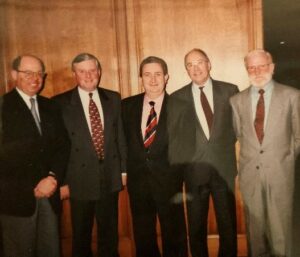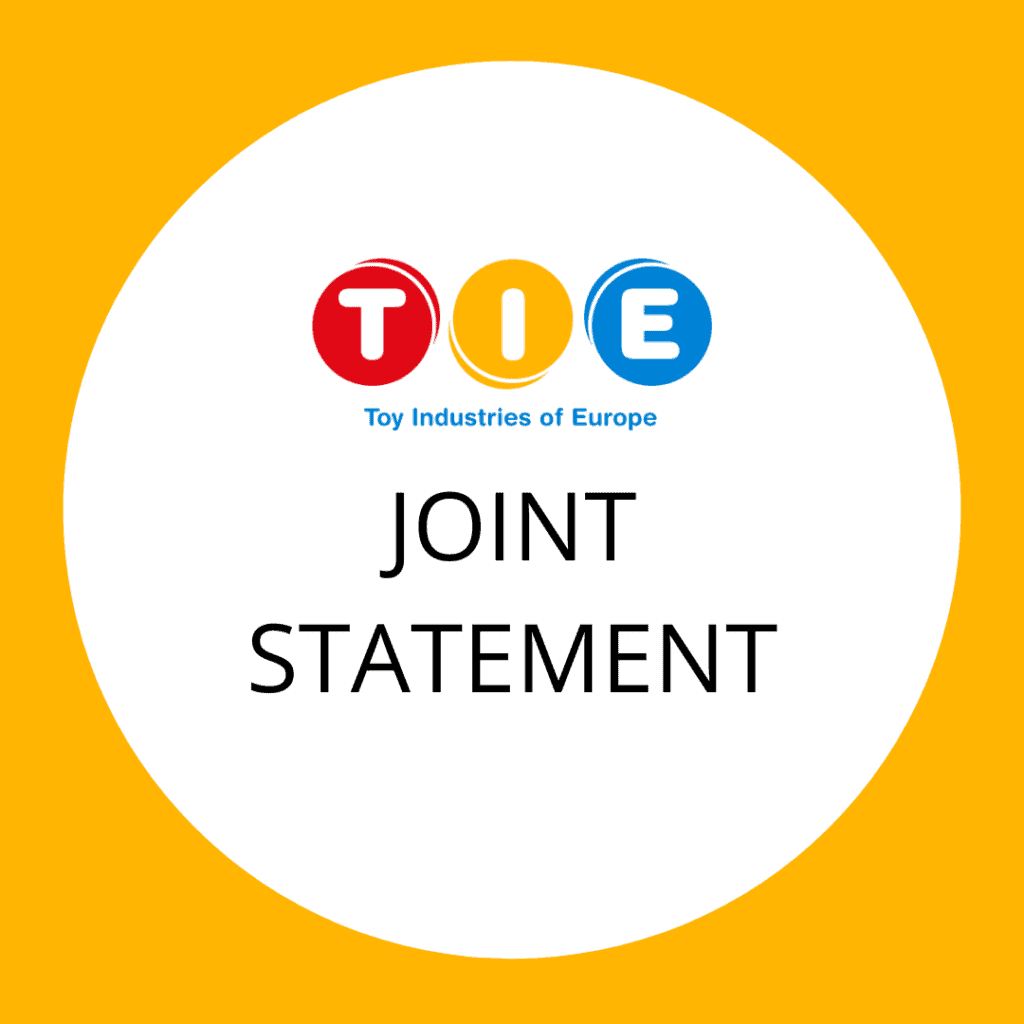1991 was an exceptional year: The Cold War ended, Disney’s first Beauty and the Beast film was released and the World Wide Web was created. But, the most exciting development surely has to be the foundations being laid for the birth of Toy Industries of Europe (TIE)!
Laying the Foundations
Thirty years ago, toy makers across the EU saw the benefits of working together to face the challenges and seize the opportunities of the nascent single market. In parallel to the work that the Fédération Européenne des industries du Jouet (FEJ) was already doing on behalf of national toy associations, they decided to create the association Toy Manufacturers of Europe (TME).

Circa 1996, amid discussions on the merger of TME & FEJ. From left to right: Daniel Aboaf (FJP), Graham Benison (Mattel), Salvador Miró (AEFJ), Jean-Paul Charpentier (Lego) and Joan Sallent (Educa-Sallent)
Over the next few years, the two associations simultaneously worked to promote the sector, the value of common European rules and standards for toy safety, the importance of protecting the sector’s intellectual property and ethical manufacturing practices to policy makers in Brussels and beyond. It became clear that joining together as a single group would strengthen this work, and so, in 1997, they united to form Toy Industries of Europe (TIE).
The Early Years
In the year that TIE became the voice of the reputable toy sector, Buzz Lightyear, Teletubbies and Tamagotchi were some of kids’ favourite toys. Jean-Paul Charpentier (Lego) and Salvador Miró (AEFJ) became TIE’s first presidents that year, whilst Graham Benison (Mattel) was appointed as Director.
In this initial period of development, TIE set out six core values for members, which continue to guide the work of the association today:
- Prioritising the safety of the toys we produce
- Ethical manufacturing
- Tailoring our marketing to respect children’s sensitivities and advertising responsibly
- Reducing or eliminating barriers to trade
- Respecting intellectual property rights in their broadest sense
- Encouraging environmental sustainability.
In the ten years that followed, TIE promoted the interests of the sector as the EU and its single market expanded. Challenges faced ranged from making sure that reputable companies were up-to-date with new rules for chemicals in toys to national bans on marketing to children in Sweden and Greece.
Changing Gear
2007 marked a sea change for the toy sector when the toy sector’s bible – EU Toy Safety Directive – was put up for revision, following the adoption of strengthened EU rules for the single market for goods and updated market surveillance rules.
The sector worked together over the next two years to ensure that the new toy safety rules were realistic and reflected the realities of the toy sector. The Revised Toy Safety Directive was finally adopted in 2009. Over 10 years later, it is still recognised as one of the most robust toy safety frameworks, mainly because it was designed to evolve in line with new scientific developments.
This turbulent period led members to recognise that a permanent secretariat would be of value. At the end of 2009, as the TSD came into force Catherine Van Reeth was appointed as TIE’s Director General. Her first tasks were building a team who could educate the sector on the new toy safety rules and ensure that the sector’s interests were reflected in the implementation of the rules.
In the following years, Catherine oversaw a pan-EU Toy Safety Roadshow, funded by the Commission, that reached over 1000 toy industry professionals in 24 countries. She also brought the importance of play front and centre in TIE’s work, starting with the creation of a Play Task Force in 2010.
More Recent History
In the last five years, TIE has continued its evolving work to share the perspective of the sector regarding the implementation of the TSD and promoting the message that changes should be made on sound scientific evidence, not driven by emotion. TIE has also maintained a strong relationship with the EU standardisation bodies responsible for the Standards that help manufacturers conform with the TSD.
TIE’s remit has expanded as the toys children play with and consumer attitudes change. Drones, cybersecurity and privacy, are just a few of the issues that the secretariat works on today that would have been almost unimaginable thirty years ago.
Nevertheless, TIE’s core messages remain the same:

Protecting and promoting reputable toy makers and the importance of play in children’s lives are still at the heart of everything TIE does. This is clearly seen in some of the projects that TIE has carried out in recent years:
- Protecting reputable toy makers from legal loopholes that allow dishonest traders to sell dangerous toys on line through our investigation into third party sales on online platforms
- Promoting reputable toy makers who are going that extra mile through our #PlayForChangeAwards
- Highlighting the importance of play in children’s lives to EU policy makers through our #PlayShapes campaigns
Like everyone else, TIE felt the impact of the pandemic in 2020. We have had to adopt new ways of working and bringing our members together. The Board of Directors, led by Sanjay Luthra of Mattel, have guided us through these challenges. In response to the shifting landscape of public health measures, TIE has been acting as an EU level platform for discussions between members and monitoring the latest developments. One positive thing that the last year has underlined, is just how important play is in the lives of children and their families.
What’s next for TIE?
Who knows what challenges the next thirty years will bring for the toy sector. One thing is certain, TIE will be there to protect and promote its members and highlighting the importance of play will remain one of our most important tasks, after all, that’s what makes the toy sector tick!
Special thanks to Daniel Aboaf, Roland Earl, Bryan Ellis, Yann Le Tallec, Alan Munn, and José Pastor for providing valuable and insightful background information on TIE’s founding years for this article.

